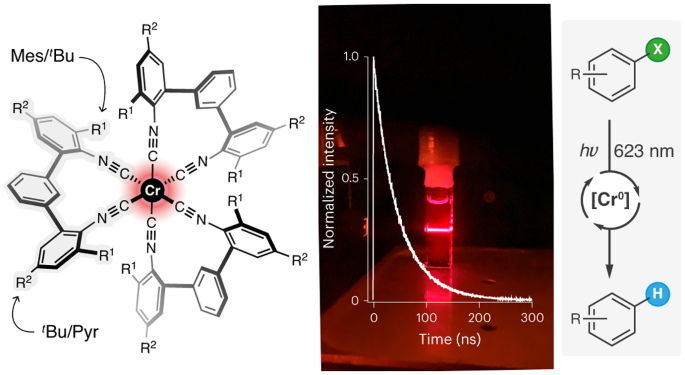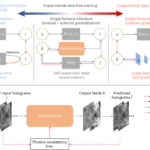2023-08-14 英国・バース大学

- バース大学が、発光材料や触媒としてオスミニウムやルテニウム等の貴金属を代替できる、クロミウム化合物を開発。
- 新クロミウム化合物では、貴金属に類似した形態でクロミウムを含めることで、貴金属を含む材料に極めて近い発光・触媒特性を達成。オスミニウム化合物に近い発光特性を備えるが、クロミウムの賦存量はオスミニウムの約 20,000 倍で価格もはるかに低い。
- 赤色光の照射で分子に光エネルギーを蓄え、後に電源として機能する。光化学反応を効率的に促す触媒としても有効で、ソーラーフューエルを生産する人工光合成の新材料として利用する可能性も期待できる。
- 炭素、窒素と水素の各原子から成る頑丈な有機分子フレームワークにクロミウム原子を格納することで、クロミウム原子による発光とエネルギー変換を可能にした。光を照射すると貴金属よりも高い反応性を示す。
- このようなカスタムメードの環境により、分子振動によるエネルギー損失を最小限に抑え、発光と触媒の特性を最適化した。ただし、不利な点はクロミウムには貴金属よりも複雑なフレームワークが必要であること。
- 主に鉄や銅等を中心とした、貴金属を使用しない持続可能でコスト効果的な材料開発は他にも成果がみられ、クロミウムを発光材料として使用する試みもある。しかし、それらの多くは高価な貴金属を含んでいる材料のような発光・触媒特性をもたない。
- 鉄、銅、クロミウムのうちのどの材料が将来の発光材料や人工光合成のアプリケーションに活用可能かは現時点では決定していないが、今回の研究成果は重要な進展。
- 今後は、新材料の大規模な開発により、幅広いアプリケーションの試験を実施する予定。さらに改良を進め、青色から緑色、赤色の発光を目指す。また、触媒特性の最適化も進め、人工光合成の可能性を探る。
- URL: https://www.unibas.ch/en/News-Events/News/Uni-Research/Chromium-replaces-rare-and-expensive-noble-metals.html
<NEDO海外技術情報より>
関連情報
Nature Chemistry 掲載論文(フルテキスト)
Photoredox-active Cr(0) luminophores featuring photophysical properties competitive with Ru(II) and
Os(II) complexes
URL: https://www.nature.com/articles/s41557-023-01297-9
Abstract
Coordination complexes of precious metals with the d6 valence electron configuration such as Ru(II), Os(II) and Ir(III) are used for lighting applications, solar energy conversion and photocatalysis. Until now, d6 complexes made from abundant first-row transition metals with competitive photophysical and photochemical properties have been elusive. While previous research efforts focused mostly on Fe(II), we disclose that isoelectronic Cr(0) gives access to higher photoluminescence quantum yields and excited-state lifetimes when compared with any other first-row d6 metal complex reported so far. The luminescence behaviour of the metal-to-ligand charge transfer excited states of these Cr(0) complexes is competitive with Os(II) polypyridines. With these Cr(0) complexes, the metal-to-ligand charge transfer states of first-row d6 metal complexes become exploitable in photoredox catalysis, and benchmark chemical reductions proceed efficiently under low-energy red illumination. Here we demonstrate that appropriate molecular design strategies open up new perspectives for photophysics and photochemistry with abundant first-row d6 metals.




